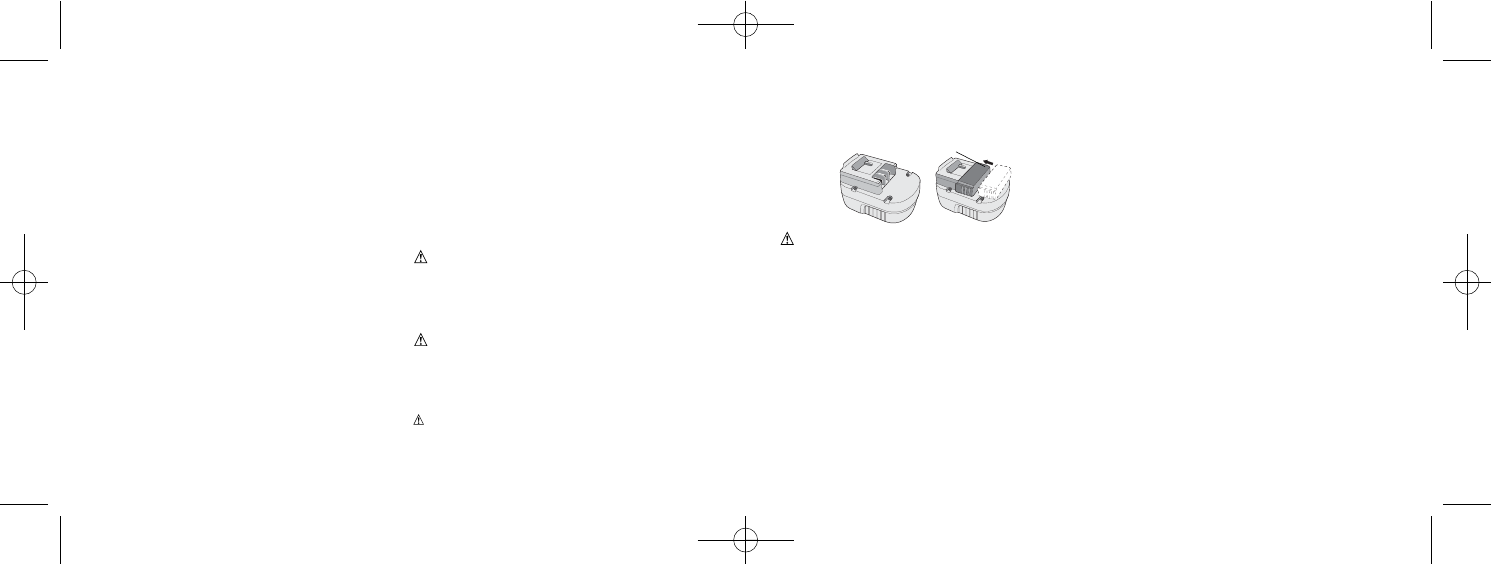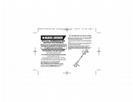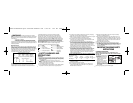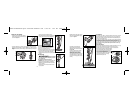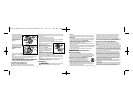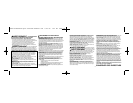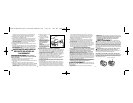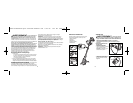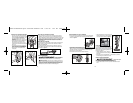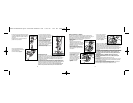LEAVING THE BATTERY PACK IN THE CHARGER
It is OK to leave battery packs on charge for long periods of time. The
charger has a maintenance mode which gives the battery pack
enough charge to stay “topped off”. If however, the tool is not
expected to be needed for more than 30 days, unplug the charger
and store battery pack in a cool, dry location. NOTE: A battery pack
will lose its charge when kept off of the charger. If the battery pack
has not been kept on maintenance charge, it may need to be
recharged before use. A battery pack may also lose its charge if left in
a charger that is not plugged into an appropriate AC source.
18 AND 24 VOLT BATTERY PACKS
The NST1024 trimmer accepts the following 18 and 24 volt Black and
Decker battery packs: 24V battery (Model HPNB24) and 18V
batteries (Models HPB18-OPE and 244760-00).
NOTE: This trimmer will also accept B&D 18V slide packs.
2b) When charging is complete the green LED will go off.
3. Unplug charger, and remove the battery pack. Place the battery
pack into the tool until it “clicks” into place.
NOTE: To remove the battery pack, press down on the release
button on the back of the battery pack and slide out.
IMPORTANT CHARGING NOTES
1. After normal usage, your battery pack should be fully charged in
9 to 11 hours. If the battery pack is run-down completely, it may
take up to 11 hours to become fully charged. Your battery pack
was sent from the factory in an uncharged condition. Before
attempting to use it, it must be charged for at least 11 hours.
2. DO NOT charge the battery pack in an air temperature below
+40°F(+4.5°C), or above +105°F (+40.5°C). This is important and
will prevent serious damage to the battery pack. Longest life and
best performance can be obtained if battery pack is charged
when air temperature is about 75°F (24°C).
3. While charging, the charger may hum and become warm to
touch. This is a normal condition and does not indicate a problem.
4. If the battery pack does not charge properly—(1) Check current
at receptacle by plugging in a lamp or other appliance. (2) Check
to see if receptacle is connected to a light switch which turns
power off when you turn out the lights. (3) Move charger and
battery pack to a surrounding air temperature of 40°F (+4.5°C) to
105°F (+40.5°C). (4) If the receptacle and temperature are OK,
and you do not get proper charging, take or send the battery
pack and charger to your local Black & Decker service center.
See Tools Electric in yellow pages.
5. The battery pack should be recharged when it fails to produce
sufficient power on jobs which were easily done previously. DO
NOT CONTINUE using unit with its battery pack in a depleted
condition.
6. The battery pack will reach optimum performance after being
cycled 5 times during normal usage. There is no need to run the
battery pack down completely before recharging. Normal usage
is the best method of discharging and recharging the battery
pack.
READ ALL INSTRUCTIONS
• Do not incinerate the battery pack even if it is severely
damaged or is completely worn out. The battery pack can
explode in a fire.
• Do not charge or use battery in explosive atmospheres, such
as in the presence of flammable liquids, gases or dust. Inserting
or removing the battery from the charger may ignite the dust or fumes.
• If battery contents come into contact with the skin,
immediately wash area with mild soap and water. If battery liquid
gets into the eye, rinse water over the open eye for 15 minutes or
until irritation ceases. If medical attention is needed, the liquid is a
25-35% solution of potassium hydroxide.
• Contents of opened battery cells may cause respiratory
irritation. Provide fresh air. If symptoms persists, seek medical
attention.
WARNING: Burn hazard. Battery liquid may be
flammable if exposed to spark or flame.
• Charge the battery packs only in Black & Decker chargers.
• DO NOT splash or immerse in water or other liquids.
• Do not store or use the tool and battery pack in locations
where the temperature may reach or exceed 105°F (40˚) (such
as outside sheds or metal buildings in summer).
WARNING: Never attempt to open the battery pack
for any reason. If battery pack case is cracked or damaged, do not
insert into charger. Do not crush, drop or damage battery pack. Do
not use a battery pack or charger that has received a sharp blow,
been dropped, run over or damaged in any way (i.e., pierced with a
nail, hit with a hammer, stepped on). Damaged battery packs should
be returned to service center for recycling.
CAUTION: When not in use, place tool on its side on a stable
surface where it will not cause a tripping or falling hazard. Some
tools with large battery packs will stand upright but may be easily
knocked over.
Battery Cap Information
A battery storage and carrying cap is provided for use whenever the
battery is out of the tool or charger. Remove cap before placing
battery in charger or tool.
WARNING:Fire hazard. Do not store or carry
battery so that metal objects can contact exposed battery
terminals. For example, do not place battery in aprons, pockets, tool
boxes, product kit boxes, drawers, etc., with loose nails, screws, keys,
etc. Transporting batteries can possibly cause fires if the battery
terminals inadvertently come in contact with conductive
materials such as keys, coins, hand tools and the like. The US
Department of Transportation Hazardous Material Regulations (HMR)
actually prohibit transporting batteries in commerce or on airplanes
(i.e., packed in suitcases and carry-on luggage) UNLESS they are
properly protected from short circuits. So when transporting individual
batteries, make sure that the battery terminals are protected and well
insulated from materials that could contact them and cause a short
circuit.
STORAGE RECOMMENDATION
1. Store tool:
a.) with the battery pack removed and on the charger.
b.) in a place that is cool and dry away from direct sunlight and excess
heat or cold.
c.) out of the reach of children.
2. For prolonged storage such as over the winter, the battery pack
should be fully charged and then removed from the charger. It
should be charged again just prior to use.
Battery Cap
6
7












